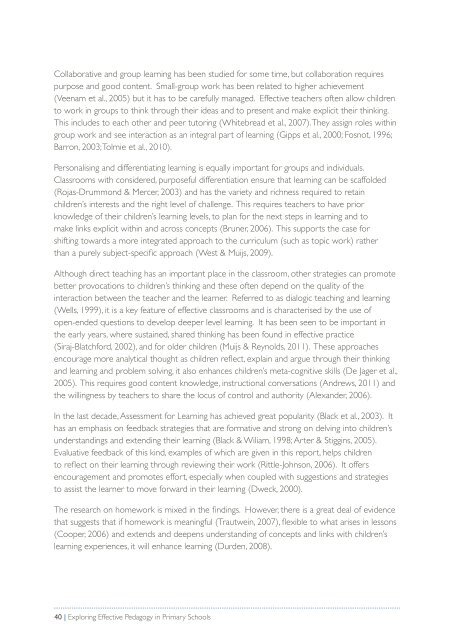Pearson-Exploring-Effective-Pedagogy-in-Primary-Schools
Pearson-Exploring-Effective-Pedagogy-in-Primary-Schools
Pearson-Exploring-Effective-Pedagogy-in-Primary-Schools
You also want an ePaper? Increase the reach of your titles
YUMPU automatically turns print PDFs into web optimized ePapers that Google loves.
Collaborative and group learn<strong>in</strong>g has been studied for some time, but collaboration requirespurpose and good content. Small-group work has been related to higher achievement(Veenam et al., 2005) but it has to be carefully managed. <strong>Effective</strong> teachers often allow childrento work <strong>in</strong> groups to th<strong>in</strong>k through their ideas and to present and make explicit their th<strong>in</strong>k<strong>in</strong>g.This <strong>in</strong>cludes to each other and peer tutor<strong>in</strong>g (Whitebread et al., 2007). They assign roles with<strong>in</strong>group work and see <strong>in</strong>teraction as an <strong>in</strong>tegral part of learn<strong>in</strong>g (Gipps et al., 2000; Fosnot, 1996;Barron, 2003; Tolmie et al., 2010).Personalis<strong>in</strong>g and differentiat<strong>in</strong>g learn<strong>in</strong>g is equally important for groups and <strong>in</strong>dividuals.Classrooms with considered, purposeful differentiation ensure that learn<strong>in</strong>g can be scaffolded(Rojas-Drummond & Mercer, 2003) and has the variety and richness required to reta<strong>in</strong>children’s <strong>in</strong>terests and the right level of challenge. This requires teachers to have priorknowledge of their children’s learn<strong>in</strong>g levels, to plan for the next steps <strong>in</strong> learn<strong>in</strong>g and tomake l<strong>in</strong>ks explicit with<strong>in</strong> and across concepts (Bruner, 2006). This supports the case forshift<strong>in</strong>g towards a more <strong>in</strong>tegrated approach to the curriculum (such as topic work) ratherthan a purely subject-specific approach (West & Muijs, 2009).Although direct teach<strong>in</strong>g has an important place <strong>in</strong> the classroom, other strategies can promotebetter provocations to children’s th<strong>in</strong>k<strong>in</strong>g and these often depend on the quality of the<strong>in</strong>teraction between the teacher and the learner. Referred to as dialogic teach<strong>in</strong>g and learn<strong>in</strong>g(Wells, 1999), it is a key feature of effective classrooms and is characterised by the use ofopen-ended questions to develop deeper level learn<strong>in</strong>g. It has been seen to be important <strong>in</strong>the early years, where susta<strong>in</strong>ed, shared th<strong>in</strong>k<strong>in</strong>g has been found <strong>in</strong> effective practice(Siraj-Blatchford, 2002), and for older children (Muijs & Reynolds, 2011). These approachesencourage more analytical thought as children reflect, expla<strong>in</strong> and argue through their th<strong>in</strong>k<strong>in</strong>gand learn<strong>in</strong>g and problem solv<strong>in</strong>g, it also enhances children’s meta-cognitive skills (De Jager et al.,2005). This requires good content knowledge, <strong>in</strong>structional conversations (Andrews, 2011) andthe will<strong>in</strong>gness by teachers to share the locus of control and authority (Alexander, 2006).In the last decade, Assessment for Learn<strong>in</strong>g has achieved great popularity (Black et al., 2003). Ithas an emphasis on feedback strategies that are formative and strong on delv<strong>in</strong>g <strong>in</strong>to children’sunderstand<strong>in</strong>gs and extend<strong>in</strong>g their learn<strong>in</strong>g (Black & Wiliam, 1998; Arter & Stigg<strong>in</strong>s, 2005).Evaluative feedback of this k<strong>in</strong>d, examples of which are given <strong>in</strong> this report, helps childrento reflect on their learn<strong>in</strong>g through review<strong>in</strong>g their work (Rittle-Johnson, 2006). It offersencouragement and promotes effort, especially when coupled with suggestions and strategiesto assist the learner to move forward <strong>in</strong> their learn<strong>in</strong>g (Dweck, 2000).The research on homework is mixed <strong>in</strong> the f<strong>in</strong>d<strong>in</strong>gs. However, there is a great deal of evidencethat suggests that if homework is mean<strong>in</strong>gful (Trautwe<strong>in</strong>, 2007), flexible to what arises <strong>in</strong> lessons(Cooper, 2006) and extends and deepens understand<strong>in</strong>g of concepts and l<strong>in</strong>ks with children’slearn<strong>in</strong>g experiences, it will enhance learn<strong>in</strong>g (Durden, 2008).40 | <strong>Explor<strong>in</strong>g</strong> <strong>Effective</strong> <strong>Pedagogy</strong> <strong>in</strong> <strong>Primary</strong> <strong>Schools</strong>


